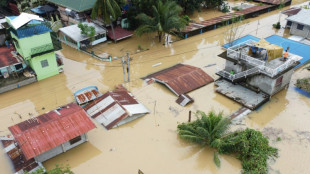
-
 Gaza hospital shut after Israeli raid, director held: health officials
Gaza hospital shut after Israeli raid, director held: health officials
-
Surgery for French skier Sarrazin 'went well': federation

-
 Mitchell, Bracewell boost New Zealand in Sri Lanka T20
Mitchell, Bracewell boost New Zealand in Sri Lanka T20
-
Kyrgios says tennis integrity 'awful' after doping scandals

-
 S. Korean prosecutors say Yoon authorised 'shooting' during martial law bid
S. Korean prosecutors say Yoon authorised 'shooting' during martial law bid
-
Vendee Globe skipper Pip Hare limps into Melbourne after dismasting

-
 Reddy's defiant maiden ton claws India back into 4th Australia Test
Reddy's defiant maiden ton claws India back into 4th Australia Test
-
Doubles partner Thompson calls Purcell doping case 'a joke'

-
 Reddy reaches fighting maiden century for India against Australia
Reddy reaches fighting maiden century for India against Australia
-
Sabalenka enjoying 'chilled' rivalry with Swiatek

-
 Political turmoil shakes South Korea's economy
Political turmoil shakes South Korea's economy
-
New mum Bencic wins first tour-level match since 2023 US Open

-
 'Romeo and Juliet' star Olivia Hussey dies aged 73
'Romeo and Juliet' star Olivia Hussey dies aged 73
-
Brown dominates as NBA champion Celtics snap skid

-
 Indian state funeral for former PM Manmohan Singh
Indian state funeral for former PM Manmohan Singh
-
France asks Indonesia to transfer national on death row

-
 Ambitious Ruud targets return to top five in 2025
Ambitious Ruud targets return to top five in 2025
-
Late bloomer Paolini looking to build on 'amazing' 2024

-
 Australia remove Pant, Jadeja as India reach 244-7 at lunch
Australia remove Pant, Jadeja as India reach 244-7 at lunch
-
Scheffler sidelined by Christmas cooking injury

-
 Rice seeks trophies as Arsenal chase down 'full throttle' Liverpool
Rice seeks trophies as Arsenal chase down 'full throttle' Liverpool
-
Trump asks US Supreme Court to pause law threatening TikTok ban

-
 Arsenal edge past Ipswich to go second in Premier League
Arsenal edge past Ipswich to go second in Premier League
-
LawConnect wins punishing and deadly Sydney-Hobart yacht race

-
 Ronaldo slams 'unfair' Ballon d'Or result after Vinicius snub
Ronaldo slams 'unfair' Ballon d'Or result after Vinicius snub
-
Several wounded N.Korean soldiers died after being captured by Ukraine: Zelensky

-
 Fresh strike hits Yemen's rebel-held capital
Fresh strike hits Yemen's rebel-held capital
-
Netflix with Beyonce make splash despite NFL ratings fall

-
 Bird flu mutated inside US patient, raising concern
Bird flu mutated inside US patient, raising concern
-
Slovakia says ready to host Russia-Ukraine peace talks

-
 Maresca challenges Chelsea to react to Fulham blow
Maresca challenges Chelsea to react to Fulham blow
-
Tech slump slays Santa rally, weak yen lifts Japan stocks higher

-
 Test records for Zimbabwe and Williams as Afghanistan toil
Test records for Zimbabwe and Williams as Afghanistan toil
-
LawConnect wins punishing Sydney-Hobart yacht race

-
 Barca's Yamal vows to 'come back better' after ankle injury
Barca's Yamal vows to 'come back better' after ankle injury
-
Olmo closer to Barcelona exit after registration request rejected

-
 Watching the sun rise over a new Damascus
Watching the sun rise over a new Damascus
-
Malaysia man flogged in mosque for crime of gender mixing

-
 Montenegro to extradite crypto entrepreneur Do Kwon to US
Montenegro to extradite crypto entrepreneur Do Kwon to US
-
Brazil views labor violations at BYD site as human 'trafficking'

-
 No extra pressure for Slot as Premier League leaders Liverpool pull clear
No extra pressure for Slot as Premier League leaders Liverpool pull clear
-
Tourists return to post-Olympic Paris for holiday magic

-
 'Football harder than Prime Minister' comment was joke, says Postecoglou
'Football harder than Prime Minister' comment was joke, says Postecoglou
-
Driver who killed 35 in China car ramming sentenced to death

-
 Bosch gives South Africa 90-run lead against Pakistan
Bosch gives South Africa 90-run lead against Pakistan
-
French skier Sarrazin 'conscious' after training crash

-
 NATO to boost military presence in Baltic after cables 'sabotage'
NATO to boost military presence in Baltic after cables 'sabotage'
-
Howe hopes Newcastle have 'moved on' in last two seasons

-
 German president dissolves parliament, sets Feb 23 election date
German president dissolves parliament, sets Feb 23 election date
-
Slot says 'too early' for Liverpool title talk

| RBGPF | 100% | 59.84 | $ | |
| CMSD | -0.67% | 23.32 | $ | |
| NGG | 0.66% | 59.31 | $ | |
| SCS | 0.58% | 11.97 | $ | |
| RIO | -0.41% | 59.01 | $ | |
| BTI | -0.33% | 36.31 | $ | |
| BP | 0.38% | 28.96 | $ | |
| CMSC | -0.85% | 23.46 | $ | |
| BCC | -1.91% | 120.63 | $ | |
| AZN | -0.39% | 66.26 | $ | |
| VOD | 0.12% | 8.43 | $ | |
| RYCEF | 0.14% | 7.27 | $ | |
| JRI | -0.41% | 12.15 | $ | |
| RELX | -0.61% | 45.58 | $ | |
| GSK | -0.12% | 34.08 | $ | |
| BCE | -0.93% | 22.66 | $ |

In Canada, deserted oil wells are environmental time bombs
With its flaking red paint, broken pressure gauge and cranks fallen to the ground, an oil well sits forsaken in western Canada, like tens of thousands of others that have been out of service for decades -- but never plugged.
Activists and experts say the existence of these inactive oil and gas installations -- often dug hundreds of meters (yards) below the surface in Alberta province -- is a ticking ecological time bomb for the vast country.
"Every single one of them is simply steel and concrete. They erode and break down," said Regan Boychuk, the founder of Reclaim Alberta, a group advocating for the clean-up of such wells.
"Every one of these holes needs to be managed, monitored for eternity because of the danger of leaks," he told AFP.
Each one of these wells also emits methane, a potent greenhouse gas that, over a 20-year period, is "86 times more impactful compared to a molecule of carbon dioxide," stresses McGill University professor Mary Kang, who has written a study on the issue.
It's a source of pollution that she believes is likely underestimated and "has a much bigger uncertainty range compared to other methane emission sources," Kang notes.
More than 120,000 oil and gas wells are inactive but not sealed off in Alberta and Saskatchewan provinces, home to more than 90 percent of Canada's wells, according to government data released in 2022.
The oldest of these has not been used since World War I.
Overall, according to that government data, these installations have emitted an average of 16,000 tonnes of methane per year over a century -- the equivalent of 545,000 tonnes of carbon dioxide annually, or what about 237,000 vehicles emit in one year.
- Work postponed indefinitely -
Most of the wells were built sometime between the dawn of the oil and gas era in the 1860s and the end of the 1940s. In some provinces of Canada, which has the world's fourth largest proven oil reserves, they are not even registered.
After decades of industrial expansion, Alberta -- home to most of the country's oil resources, mainly in the form of oil sands -- saw the number of inactive wells increase rapidly since 2010, particularly after crude prices dropped off in 2014.
Under the polluter-pay principle enshrined in Canadian law, energy companies must pay for the plugging of wells and cleanup of the surrounding area, but there is thus far no deadline for that work to be completed.
This allows oil and gas firms to postpone the work indefinitely, or to transfer their inactive wells to smaller companies.
When these companies file for bankruptcy, the environmental burden for orphaned wells falls to provincial authorities -- and creates another bureaucratic nightmare.
Over roughly a decade, the number of orphaned wells in Alberta exploded, from 700 in 2010 to almost 10,000 in 2023.
The government in Ottawa says the cost of cleaning them up will soar from CAN $361 million (US $272 million) in 2020 to $1.1 billion in 2025.
While the Orphan Well Association in Alberta plans to get the job done over the next 10 to 12 years, some say the monumental task has been wildly misjudged.
"There are tens of thousands that fit the common sense definition, but only a few thousand are officially designated," Boychuk says.
- Polluted soil -
Albert Hummel, a farmer in southern Alberta, had seven abandoned wells on his land. But he's one of the lucky ones -- some of them were finally sealed off and "reclaimed," or restored to their original state. There are two left to handle.
"It's a slow process, it takes time," says Hummel, who lost the royalties he was earning for the use of his land once the oil company in question went out of business in 2019.
Once the soil is contaminated, it takes decades for the pollutants to evaporate. Only then can cleanup work begin.
After the ground is purified, the wells must be plugged with cement, each layer of soil carefully replaced, and the area leveled off with the surrounding fields for it to be considered "reclaimed."
Right in the middle of one of Hummel's fields, the remains of a well have prevented the farmer from using part of that land -- "it's just straight loss of production," he says, pointing to the pipes emerging from the earth.
In an effort to offset the loss and render the area at least partially useful, one small company has offered to install solar panels until the ground can be decontaminated.
"It just gives nature more time for the grass to come back, for contaminants to evaporate," says Daryl Bennett from the RenuWell project.
"It'll give a little more time to clean up the land and reclaim it, and it's producing renewable energy too."
But such solutions represent a drop in the bucket when compared to the overall cleanup at hand.
"Emissions from this legacy infrastructure, they're not going to go away," says Kang.
"It's something we're going to have to manage for years and decades to come."
T.Batista--PC




